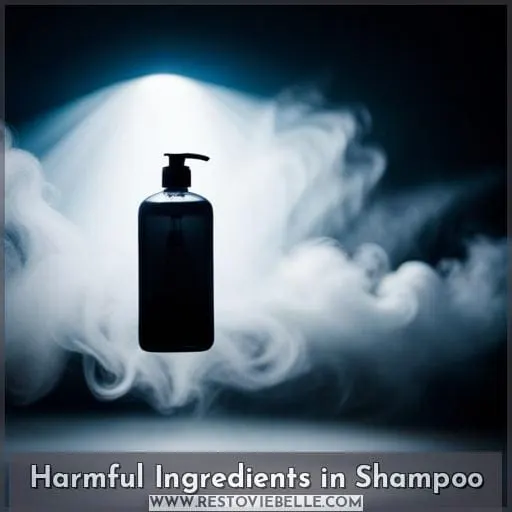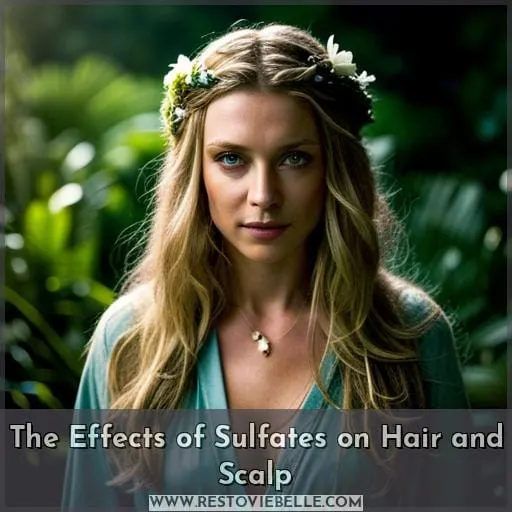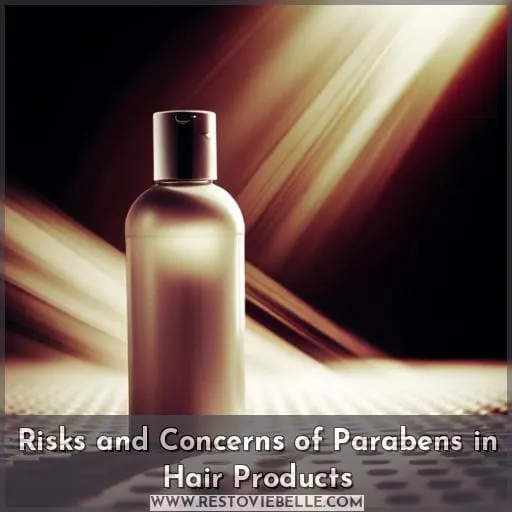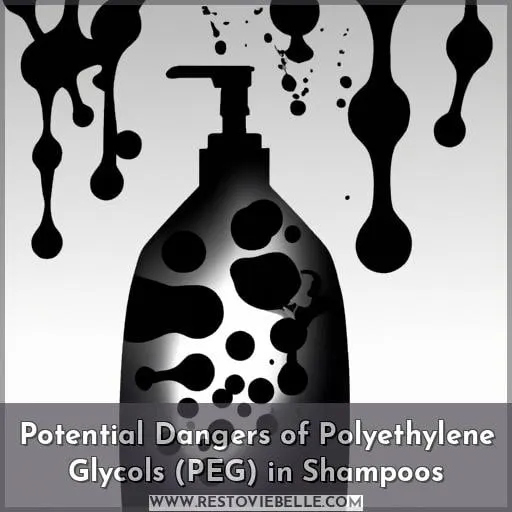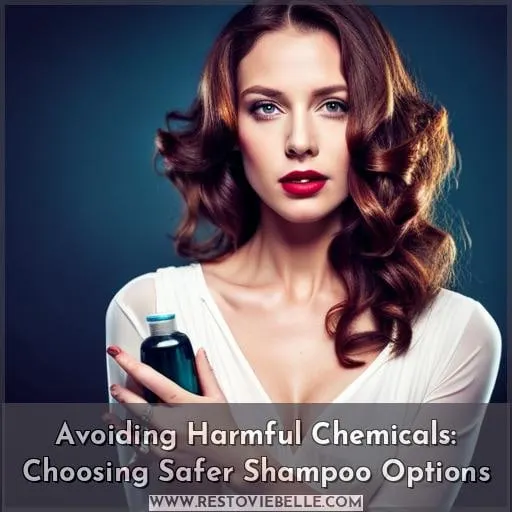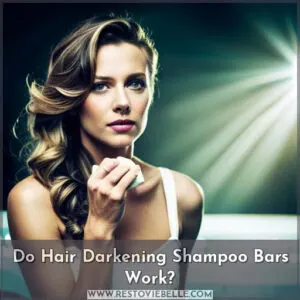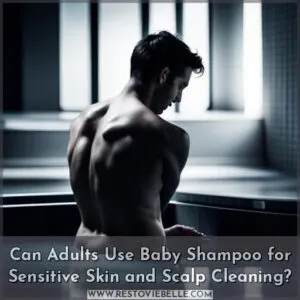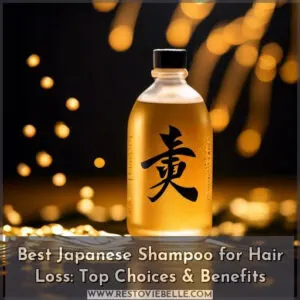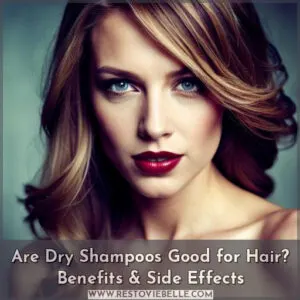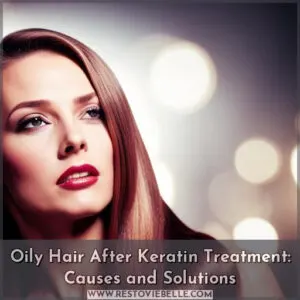This site is supported by our readers. We may earn a commission, at no cost to you, if you purchase through links.
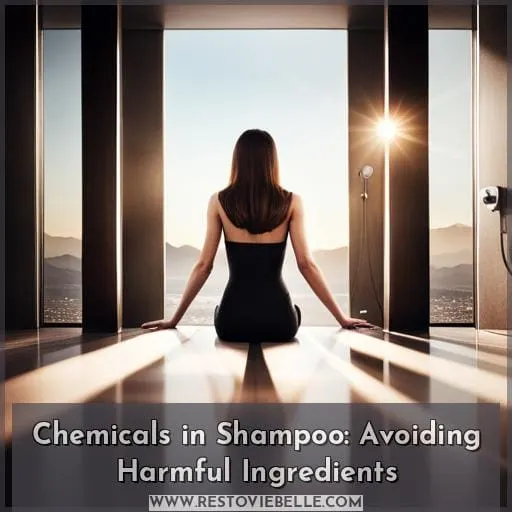 Investigate the truth of a theory and uncover the hidden dangers lurking in your shampoo bottle.
Investigate the truth of a theory and uncover the hidden dangers lurking in your shampoo bottle.
Chemicals in shampoo can have harmful effects on both your hair and overall health. From sulfates to parabens, these ingredients pose risks that you need to be aware of.
In this article, we will delve into the potential dangers of these chemicals and provide tips on how to choose safer shampoo options without sacrificing effectiveness or performance.
Take control over what you put on your head – it’s time for a clean start!
Table Of Contents
- Key Takeaways
- Harmful Ingredients in Shampoo
- The Effects of Sulfates on Hair and Scalp
- Risks and Concerns of Parabens in Hair Products
- Potential Dangers of Polyethylene Glycols (PEG) in Shampoos
- Avoiding Harmful Chemicals: Choosing Safer Shampoo Options
- Frequently Asked Questions (FAQs)
- Are all sulfates harmful for hair and scalp health?
- What are the potential risks of using paraben-free shampoos?
- Are there any safe alternatives to polyethylene glycols (PEGs) in shampoos?
- How can triclosan in shampoos affect the immune system?
- What are some key factors to consider when choosing safer shampoo options?
- Conclusion
Key Takeaways
- Sulfates strip natural oils and color, potentially forming carcinogens.
- Parabens disrupt hormone balance and increase the risk of breast cancer.
- Polyethylene Glycols (PEGs) strip hair moisture and may contain carcinogenic impurities.
- It is important to choose sulfate-free, paraben-free, and PEG-free shampoo options for scalp health and overall well-being.
Harmful Ingredients in Shampoo
When it comes to selecting a shampoo, it’s important to be aware of the harmful ingredients that may be present.
- Sulfates can strip natural oils and moisture from your hair and scalp, causing dryness and irritation.
- Parabens act as preservatives but disrupt hormone balance and can lead to skin irritation and reproductive health issues.
- Polyethylene Glycols (PEG) are often derived from petroleum, stripping hair of moisture and being classified as a developmental toxicant with links to cancer.
- Phthalates are known hormone disruptors that have negative effects on both human health and the environment.
- Lastly, formaldehyde is a well-known carcinogen found in many hair care products that can cause toxicity when absorbed through the scalp.
Sulfates
Sulfates are one of the most common harmful ingredients found in shampoos and can cause damage to your hair and scalp.
They strip natural oils, moisture, and color from hair while potentially forming carcinogens.
Consider sulfate alternatives for maintaining moisture balance, protecting hair color, preserving natural oils, and preventing irritation based on a literature review.
Parabens
When it comes to harmful ingredients in shampoo, one that you should be aware of is parabens.
They can cause hormone disruption, pose preservative dangers, and act as shelf life extenders in hair care products.
Regulatory bodies require labels to disclose their presence due to potential risks for reproductive health and skin irritation.
Polyethylene Glycols (PEG)
To ensure you’re making informed decisions about the shampoo you use, it’s important to understand the potential risks associated with harmful ingredients such as polyethylene glycols (PEGs).
PEGs can strip moisture from hair, act as a developmental toxicant, and have been linked to cancer.
Consider safer alternatives for scalp nourishment.
Phthalates
Phthalates pose potential risks as harmful ingredients in shampoo, impacting your health and the environment.
These chemicals can disrupt hormones and have environmental concerns.
Look for Phthalate-Free choices to avoid their impact on hair care products.
Formaldehyde
Formaldehyde, a known carcinogen, is an ingredient to be aware of in shampoos.
It can be absorbed by the scalp and has toxicity concerns.
Exposure to formaldehyde and formaldehyde releasers can lead to hair moisture loss and have carcinogenic effects.
The Effects of Sulfates on Hair and Scalp
When using shampoos containing sulfates, you may experience negative effects on your hair and scalp.
Sulfates are known for their ability to strip natural oils and moisture from the hair, leading to dryness and potential flaking. Additionally, sulfates can cause irritation on the scalp, especially for individuals with sensitivity issues.
Sodium laureth sulfate (SLES), a common sulfate found in many shampoos, has been linked to skin irritation due to its strong cleansing properties. This ingredient can disrupt the delicate balance of your scalp’s natural oils and pH levels.
To combat these risks associated with sulfates in shampoo products, consider exploring sulfate-free options available on the market today. By choosing sulfate-free formulas that use milder surfactants or alternative cleaning agents like cocamidopropyl betaine or decyl glucoside instead of sodium lauryl/laureth sulfate (SLS/SLES), you can minimize moisture stripping while still effectively cleansing your hair.
Consulting a professional hairstylist or dermatologist who specializes in hair care is advisable if you have concerns about specific products or need personalized recommendations based on your unique needs.
Risks and Concerns of Parabens in Hair Products
Parabens pose risks and concerns in hair products due to their potential harm to your health.
These preservatives, commonly found in shampoos and conditioners, have been linked to hormone disruption and estrogenic mimicry. Parabens can mimic the effects of estrogen in the body, potentially increasing the risk of breast cancer development.
The use of parabens as preservatives is a common practice in the personal care industry due to their ability to extend shelf life by inhibiting bacterial growth. However, these paraben pitfalls come at a cost that may outweigh their benefits.
Studies have suggested that exposure to parabens can accumulate over time through repeated use of hair products containing these chemicals.
As consumers become more aware of the potential dangers associated with harmful ingredients like parabens, there’s been an increased demand for safer alternatives in hair care products. Many brands now offer paraben-free options which reduce exposure to these potentially harmful substances while still providing effective preservation methods for product longevity.
Potential Dangers of Polyethylene Glycols (PEG) in Shampoos
Now that you understand the risks and concerns of parabens in hair products, it’s crucial to explore another potentially harmful ingredient found in shampoos: Polyethylene Glycols (PEGs).
PEGs are petroleum-derived compounds commonly used as emollients, thickeners, and moisture-binding agents. However, their use has raised significant concerns due to their potential dangers.
One major issue with PEGs is their moisture-stripping effect on hair. These compounds have a high affinity for water molecules, which means they can draw out essential moisture from the hair shaft and scalp.
Furthermore, studies have shown that certain forms of polyethylene glycol contain impurities called ethylene oxide or 1-4,dioxane – both known carcinogens linked to cancer development. Additionally,polyethylene glycol has been classified as a developmental toxicant capable of causing fetal harm during pregnancy.
Despite these concerning findings regarding PEG toxicity,Clinical safety assessments conducted by regulatory agencies such as the FDA continue deem them safe for use within specific concentration limits.
Yet,it remains important be cautious when selecting shampoos containing this compound,and consider safer alternatives that prioritize your overall health,hair health included.
Avoiding Harmful Chemicals: Choosing Safer Shampoo Options
When selecting a shampoo, it’s important to consider safer alternatives that can minimize potential health risks and have a positive impact on the environment.
Safer options may include:
- Sulfate-free formulas with milder surfactants
- Humectants like coconut oil or quaternium salts for moisture retention
- Conditioners containing nourishing ingredients such as Vitamin E or argan oil
Being mindful of ingredient disclosure, potential allergens even in plant-derived ingredients, and proactive label reading can help make more informed purchases.
By choosing safer shampoo options, you not only prioritize your own well-being but also contribute to reducing the use of harmful chemicals in hair care products.
Safer shampoo alternatives
To protect your hair and scalp from harmful chemicals, it’s crucial to opt for safer shampoo alternatives.
- Natural Emollients: Look for shampoos that contain plant-derived ingredients like aloe vera, coconut oil, or chamomile to nourish and moisturize your hair.
- Organic Formulas: Choose shampoos made with certified-organic ingredients to minimize exposure to synthetic chemicals.
- Ingredient Transparency: Select brands that provide clear ingredient lists so you can make informed purchases while avoiding potentially harmful surfactants and additives.
Potential health risks
As you consider safer shampoo alternatives, it’s important to be aware of the potential health risks associated with certain ingredients.
Ingredients like sulfates, parabens, polyethylene glycols (PEG), phthalates, and formaldehyde can have detrimental effects on your health. These chemicals have been linked to hormone disruption, toxicity concerns, carcinogenic effects, reproductive health issues and hair loss.
Additionally they also pose a threat to the environment due to their harmful impact when they’re washed down drains or disposed of improperly.
| Chemicals | Health Risks |
|---|---|
| Sulfates | Hair loss |
| Parabens | Hormone disruption |
| PEG | Toxicity Concerns |
Environmental impact
Choose shampoo options that are safer for the environment by avoiding harmful chemicals.
Make eco-friendly alternatives and sustainable practices a priority when selecting your hair care products.
Opt for green beauty and planet-friendly choices that promote environmental responsibility.
Avoid ingredients like alcohol, fragrances, toluene, quaternium-15, and ethyl parabens which can have negative impacts on both your health and the environment.
Frequently Asked Questions (FAQs)
Are all sulfates harmful for hair and scalp health?
Not all sulfates are harmful, but some can strip natural oils and moisture from your hair and scalp, leading to dryness, flaking, and irritation.
It’s important to choose sulfate-free formulas for healthier hair.
What are the potential risks of using paraben-free shampoos?
Using paraben-free shampoos may seem like a liberating choice, but beware! These supposedly safer alternatives can still disrupt your hormone balance and irritate the skin.
Are there any safe alternatives to polyethylene glycols (PEGs) in shampoos?
Consider using natural alternatives to polyethylene glycols (PEGs) in shampoos.
Look for humectants like coconut oil, quaternium salts, and silicon oils that help retain moisture.
These safer ingredients provide nourishment without the potential risks associated with PEGs.
How can triclosan in shampoos affect the immune system?
Triclosan in shampoos can wreak havoc on your immune system. It acts as a carcinogen, disrupts hormones, and may lead to infertility, fetal harm, immune issues.
What are some key factors to consider when choosing safer shampoo options?
When selecting a safer shampoo, consider factors such as:
- Avoiding sulfates that strip natural oils and moisture.
- Opting for paraben-free formulas to maintain hormone balance.
- Choosing products without PEGs or triclosan to reduce the risk of toxicity.
Conclusion
To ensure the health and safety of your hair and overall well-being, it’s crucial to be aware of the harmful chemicals present in shampoo.
Sulfates, parabens, polyethylene glycols (PEG), phthalates, and formaldehyde all pose risks that can affect your hair and scalp.
By choosing safer shampoo options that are free from these harmful ingredients, you can protect yourself from potential health concerns and minimize the environmental impact.
Take control of your hair care routine and make informed choices to achieve a clean and healthy start.

